-

小班语言教案 谁会飞
2、在轻松愉快的气氛中,锻炼语言表达能力和思维能力。活动准备:1、实物投影仪,电视机。2、有活泼轻快音乐的磁带一盘,录音机一台。3画有鸟飞、鱼游、兔跳、鹿跑的图片一张。4、会飞、游、跳、跑的动物头饰三十只,大字卡:飞、游、跳、跑。活动过程:1、以妈妈带宝宝游戏的形式,在音乐声中做鸟飞、鱼游、兔跳、鹿跑的动作。边学边引导幼儿说“拍拍翅膀飞呀飞”,“摇摇尾巴游游游”,“竖起耳朵蹦蹦跳”,“四条腿儿跑跑跑”。
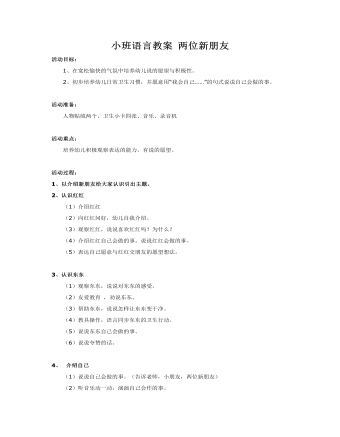
小班语言教案 两位新朋友
活动准备: 人物贴绒两个、卫生小卡四张、音乐、录音机 活动重点: 培养幼儿积极观察表达的能力,有说的愿望。 活动过程:1、以介绍新朋友给大家认识引出主题。2、认识红红 (1)介绍红红 (2)向红红问好,幼儿自我介绍。 (3)观察红红,说说喜欢红红吗?为什么? (4)介绍红红自己会做的事。说说红红会做的事。 (5)表达自己愿意与红红交朋友的愿望想法。
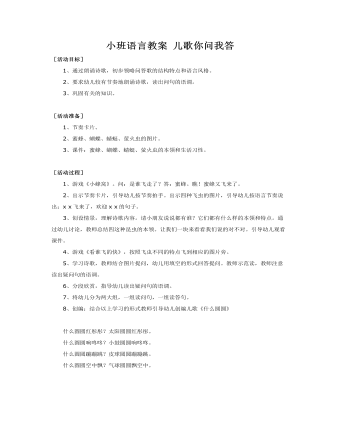
小班语言教案 儿歌你问我答
[活动准备]1、节奏卡片。2、蜜蜂、蝴蝶、蜻蜓、萤火虫的图片。3、课件:蜜蜂、蝴蝶、蜻蜓、萤火虫的本领和生活习性。 [活动过程]1、游戏《小蜂窝》。问:是谁飞走了?答:蜜蜂。瞧!蜜蜂又飞来了。2、出示节奏卡片,引导幼儿按节奏拍手。出示四种飞虫的图片,引导幼儿按语言节奏说出:x x飞来了,欢迎x x的句子。3、创设情景,理解诗歌内容。请小朋友说说都有谁?它们都有什么样的本领和特点。通过幼儿讨论,教师总结四这种昆虫的本领。让我们一块来看看我们说的对不对。引导幼儿观看课件。
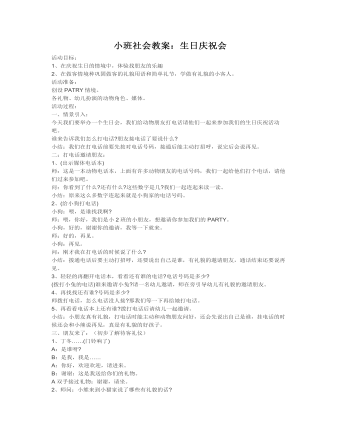
小班社会教案:生日庆祝会
2、在做客情境种巩固做客的礼貌用语和简单礼节,学做有礼貌的小客人。活动准备:创设PATRY情境。 各礼物、幼儿扮演的动物角色、媒体。活动过程:一、情景引入:今天我们要举办一个生日会,我们给动物朋友打电话请他们一起来参加我们的生日庆祝活动吧。谁来告诉我们怎么打电话?朋友接电话了要说什么?小结:我们在打电话前要先按对电话号码,接通后能主动打招呼,说完后会说再见。二:打电话邀请朋友:1、(出示媒体电话本) 师:这是一本动物电话本,上面有许多动物朋友的电话号码,我们一起给他们打个电话,请他们过来参加吧。问:你看到了什么?还有什么?这些数字是几?我们一起连起来读一读。小结:原来这么多数字连起来就是小狗家的电话号码。
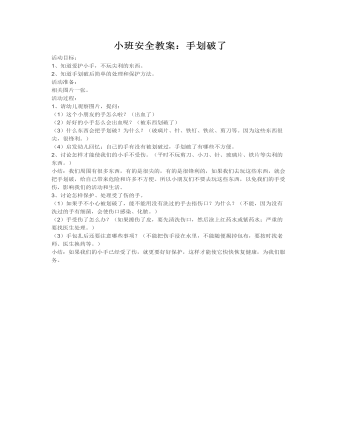
小班安全教案:手划破了
2、知道手划破后简单的处理和保护方法。 活动准备: 相关图片一张。 活动过程: 1、请幼儿观察图片,提问: (1)这个小朋友的手怎么啦?(出血了) (2)好好的小手怎么会出血呢?(被东西划破了) (3)什么东西会把手划破?为什么?(玻璃片、针、铁钉、铁丝、剪刀等。因为这些东西很尖,很锋利。) (4)启发幼儿回忆:自己的手有没有被划破过,手划破了有哪些不方便。 2、讨论怎样才能使我们的小手不受伤。(平时不玩剪刀、小刀、针、玻璃片、铁片等尖利的东西。) 小结:我们周围有很多东西,有的是很尖的,有的是很锋利的,如果我们去玩这些东西,就会把手划破,给自己带来危险和许多不方便。所以小朋友们不要去玩这些东西,以免我们的手受伤,影响我们的活动和生活。
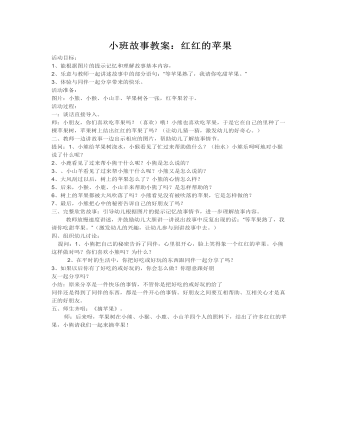
小班故事教案:红红的苹果
活动准备: 图片:小熊、小猴、小山羊、苹果树各一张,红苹果若干。 活动过程: 一:谈话直接导入。 师:小朋友,你们喜欢吃苹果吗?(喜欢)哦!小熊也喜欢吃苹果,于是它在自己的里种了一棵苹果树,苹果树上结出红红的苹果了吗?(让幼儿猜一猜,激发幼儿的好奇心。) 二、教师一边讲故事一边出示相应的图片,帮助幼儿了解故事情节。 提问:1、小熊给苹果树浇水,小猴看见了忙过来帮助做什么?(抬水)小熊乐呵呵地对小猴说了什么呢? 2、小鹿看见了过来帮小熊干什么呢?小熊是怎么说的? 3、、小山羊看见了过来帮小熊干什么呢?小熊又是怎么说的? 4、大风刮过以后,树上的苹果怎么了?小熊的心情怎么样? 5、后来,小猴、小鹿、小山羊来帮助小熊了吗?是怎样帮助的? 6、树上的苹果都被大风吹落了吗?小熊看见没有被吹落的苹果,它是怎样做的? 7、最后,小熊把心中的秘密告诉自己的好朋友了吗?
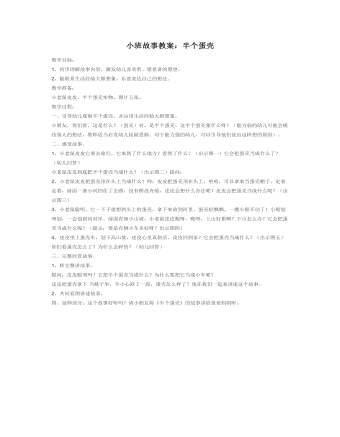
小班故事教案:半个蛋壳
2、能联系生活经验大胆想象,乐意表达自己的想法。 教学准备: 小老鼠皮皮,半个蛋壳实物,图片五张。 教学过程: 一、引导幼儿观察半个蛋壳,并运用生活经验大胆想象。 小朋友,你们看,这是什么?(蛋壳)对,是半个蛋壳。这半个蛋壳象什么呀?(能力弱的幼儿可能会模仿别人的想法,教师适当启发幼儿拓展思路。对于能力强的幼儿,可以引导他们说出这样想的原因)。 二、感受故事。 1、小老鼠皮皮它要去旅行,它来到了什么地方?看到了什么?(出示图一)它会把蛋壳当成什么了?(幼儿回答) 小老鼠皮皮到底把半个蛋壳当成什么?(出示图二)提问: 2、小老鼠皮皮把蛋壳顶在头上当成什么?师:皮皮把蛋壳顶在头上,哈哈,可以拿来当蛋壳帽子。走着走着,前面一条小河挡住了去路,没有桥没有船,皮皮会想什么办法呢?皮皮会把蛋壳当成什么呢?(出示图三)
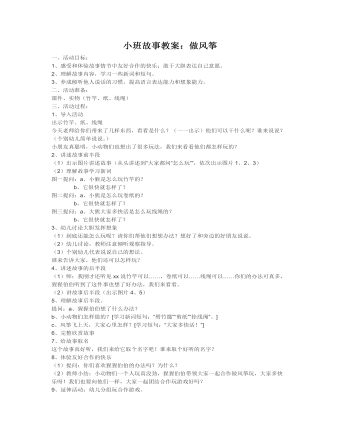
小班故事教案:做风筝
2、理解故事内容,学习一些新词和短句。 3、养成倾听他人说话的习惯,提高语言表达能力和想象能力。 二、活动准备: 课件、实物(竹竿、纸、线绳) 三、活动过程: 1、导入活动 出示竹竿、纸、线绳 今天老师给你们带来了几样东西,看看是什么?(一一出示)他们可以干什么呢?谁来说说?(个别幼儿简单说说。) 小朋友真聪明,小动物们也想出了很多玩法,我们来看看他们都怎样玩的? 2、讲述故事前半段 (1)出示图片讲述故事(从头讲述到“大家都问“怎么玩””,依次出示图片1、2、3) (2)理解故事学习新词 图一提问:a、小猴是怎么玩竹竿的? b、它很快就怎样了?
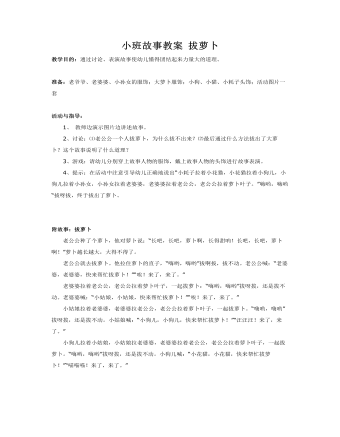
小班故事教案 拔萝卜
准备:老爷爷、老婆婆、小孙女的服饰;大萝卜服饰;小狗、小猫、小耗子头饰;活动图片一套 活动与指导:1、教师边演示图片边讲述故事。2、讨论:⑴老公公一个人拔萝卜,为什么拔不出来?⑵最后通过什么方法拔出了大萝卜?这个故事说明了什么道理?3、游戏:请幼儿分别穿上故事人物的服饰,戴上故事人物的头饰进行故事表演。4、提示:在活动中注意引导幼儿正确地说出“小耗子拉着小花猫,小花猫拉着小狗儿,小狗儿拉着小孙女,小孙女拉着老婆婆,老婆婆拉着老公公,老公公拉着萝卜叶子。”嗨哟,嗨哟“拔呀拔,终于拔出了萝卜。

小班健康教案 天天刷牙好
2、尝试沿着一条线段自上而下地画短线,初步学习正确的握笔姿势。活动准备:牙刷一把。画纸、蜡笔。 活动流程:一、引发兴趣,导入课题 教师:你们每天刷牙吗?你们是怎么样刷牙的?(告诉幼儿正确的刷牙方法。)二、讲解示范1、教师:小朋友们,牙刷是什么样子的?牙刷的刷毛又是什么样子的呢?(出示牙刷) 教师小结:牙刷毛短短的,直直的,排列得很整齐。
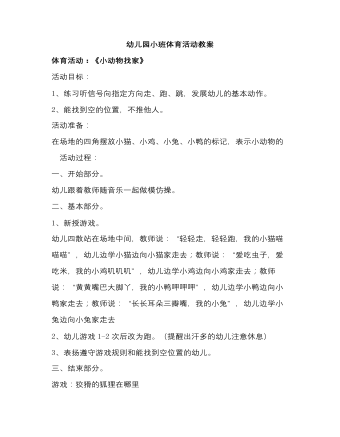
幼儿园小班体育活动教案
体育活动:《小动物找家》活动目标:1、练习听信号向指定方向走、跑、跳,发展幼儿的基本动作。2、能找到空的位置,不推他人。活动准备:在场地的四角摆放小猫、小鸡、小兔、小鸭的标记,表示小动物的 活动过程:一、开始部分。幼儿跟着教师随音乐一起做模仿操。二、基本部分。1、新授游戏。幼儿四散站在场地中间,教师说:“轻轻走,轻轻跑,我的小猫喵喵喵”,幼儿边学小猫边向小猫家走去;教师说:“爱吃虫子,爱吃米,我的小鸡叽叽叽”,幼儿边学小鸡边向小鸡家走去;教师说:“黄黄嘴巴大脚丫,我的小鸭呷呷呷”,幼儿边学小鸭边向小鸭家走去;教师说:“长长耳朵三瓣嘴,我的小兔”,幼儿边学小兔边向小兔家走去2、幼儿游戏1-2次后改为跑。(提醒出汗多的幼儿注意休息)3、表扬遵守游戏规则和能找到空位置的幼儿。三、结束部分。游戏:狡猾的狐狸在哪里 幼儿能念完儿歌再跑。

特色小吃加盟合同书
甲方为发展特色小吃,有利于 特色饮食文化的推广,运用独特技术配方和工艺,借助自身的品牌优势和媒体宣传,面向全国进行招商合作。乙方对该项目进行认真考察了解,通过全面论证后,自愿申请加盟合作。甲乙双方本着自愿、公平、诚信、规范、互惠互利、共同发展原则,经双方协商一致达成如下协议,以资共同信守:一、甲方同意乙方使用甲方的管理模式和技术,并授权乙方在_____________省_________(市、县)________(区、乡或镇)___________路开设壹家“ ”特色小吃系列。二、签订合同时一次性付清全部款项 元整,(¥ 元)。三、甲方的权利和义务1、甲方将操作技术、管理方式及企业形象识别系统授权乙方在合 同期内使用。2、甲方对乙方进行理论加实践的技术培训模式,学会为止。3、甲方对乙方所在经营地限额批准加盟店,确保乙方的经营利益。甲方对乙方经营区域保护的距离为省级市最低为2公里,县市级3公里。(注:餐车加盟类无区域保护)4、甲方有权利对乙方损害“ ”的品牌形象、泄露技术、专用配料供他店使用不良行为,做出处理方案。
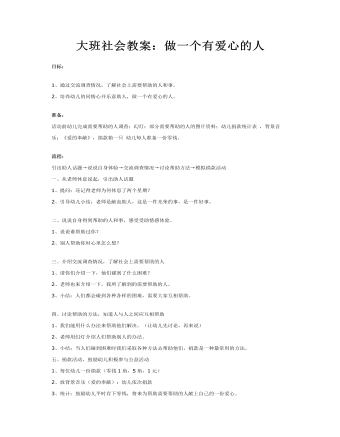
大班社会教案:做一个有爱心的人
准备:活动前幼儿完成需要帮助的人调查;幻灯:部分需要帮助的人的图片资料;幼儿捐款统计表,背景音乐:《爱的奉献》,捐款箱一只幼儿每人准备一份零钱。流程:引出助人话题→说说自身体验→交流调查情况→讨论帮助方法→模拟捐款活动一、从老师休息说起,引出助人话题 1、提问:还记得老师为何休息了两个星期?2、引导幼儿小结:老师是献血助人,这是一件光荣的事,是一件好事。二、说说自身得到帮助的人和事,感受受助情感体验。1、说说谁帮助过你?2、别人帮助你时心里怎么想?
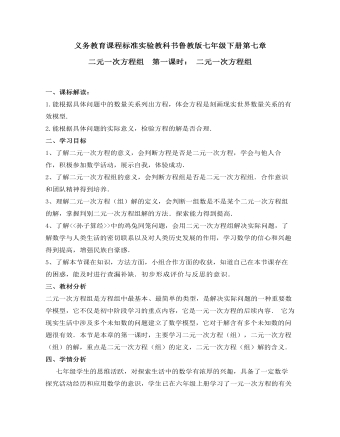
二元一次方程组教案教学设计
1、问题1的设计基于学生已有的一元一次方程的知识,学生独立思考问题,同学会考虑到题中涉及到等量关系,从中抽象出一元一次方程模型;同学可能想不到用方程的方法解决,可以由组长带领进行讨论探究.2、问题2的设计为了引出二元一次方程,但由于同学的知识有限,可能有个别同学会设两个未知数,列出二元一次方程;如果没有生列二元一次方程,教师可引导学生分析题目中有两个未知量,我们可设两个未知数列方程,再次从中抽象出方程模型.根据方程特点让生给方程起名,提高学生学习兴趣.3、定义的归纳,先请同学们观察所列的方程,找出它们的共同点,并用自己的语言描述,组内交流看法;如果学生概括的不完善,请其他同学补充. 交流完善给出定义,教师规范定义.
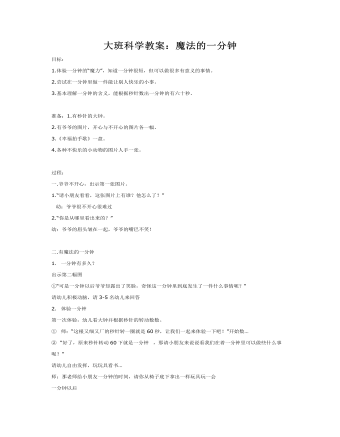
大班科学教案:魔法的一分钟
准备:1.有秒针的大钟。 2.有爷爷的图片,开心与不开心的图片各一幅。 3.《幸福拍手歌》一盘。 4.各种不快乐的小动物的图片人手一张。 过程:一.爷爷不开心,出示第一张图片。 1.“请小朋友看看,这张图片上有谁?他怎么了?” 幼:爷爷很不开心很难过 2.“你是从哪里看出来的?” 幼:爷爷的眉头皱在一起,爷爷的嘴巴不笑!

大班科学教案:不一样的石头
【活动目标】1、激发幼儿热爱大自然的情感。2、培养幼儿尊重事实的科学态度,提高自主学习的能力。3、通过观察和实验,了解石头的多样性(出处、特性),丰富地理知识。【活动准备】1、教学课件2、实验材料、用书同幼儿人数。【活动重难点】1、幼儿能说出三种石头不一样的现象。2、教师对三种石头产生不同现象后的反复引导。【活动过程】(一)开始部分 幼儿介绍自己带来的石头。(幼儿互相介绍手中的石头,鼓励幼儿自由与同伴交流,说出自己的发现)(二)基本部分1、欣赏石头风景图 大千世界,有各种各样的石头,下面就让我们一起走进美丽的石头风景中吧!2、提问、猜想、记录 (1)提问:在大自然中,石头成为美丽的风景,石头又分为哪几种,每种石头又叫什么? (幼儿讨论)并且介绍石头的正确名称观看课件,了解石头名称。 (2)猜想:①你觉得三种石头能够漂浮在水面的是哪一种?②你觉得三种石头能写字的是哪一种?③你觉得三种石头摸上去最光华的哪一种? (3)纪录: 幼儿把猜想记录在《幼儿用书》的猜想表格中。3、幼儿动手实验,感知石头的特性, (1)把石灰石、鹅卵石和火山石放在手中,感受那个摸起来最光滑。 (2)用石灰石、鹅卵石和火山石在黑卡纸画画,哪个可以画出来。 (3)把石灰石、鹅卵石和火山石放进水中,会发现哪个能浮起来。 (4)把自己发现记录在《幼儿用书》的发现表格中(教师帮助幼儿认读书中相应的正确答案)。

新人教版高中英语必修3Unit 1 Festivals and Celebrations-Reading and Thinking教学设计
The topic of this part is “Discover the reasons for festivals and celebrations.The Listening & Speaking & Talking part aims at talking about the experiences and feelings or emotions about the festivals and celebrations. This section aims at detecting the reason why the people celebrate the festivals, the time, the places, the types and the way of celebrations. It also explains why some traditions in the old celebrations are disappearing, like the firecrackers in the big cities and some new things are appearing like the prosperity of business or commerce. 1. Students can talk about what festivals they know and the reasons and the way of celebrating them.2. Students should learn the reading skills such as the headline and get the topic sentences, the structures of articles.3. Students can understand the past, the present situation of some festival around the world and why there are some changes about them. 4. Students can have the international awareness about the festivals.1. Students should learn the reading skills such as the headline and get the topic sentences, the structures of articles.2. Students can understand the past, the present situation of some festival around the world and why there are some changes about them.Step 1 Lead in---Small talkWhat festival do you like best ? Why ?I like the Spring Festivals because I can set off the fireworks, receive the lucky money and enjoy the Gala with my families.Step 2 Before reading---Pair workWhy do people celebrate different festivals ?The Spring Festivals is to celebrate the end of winter and the coming of spring and new life.The Mid-autumn Day is to celebrate the harvest and admire the moon.

新人教版高中英语必修3Unit 2 Morals and Virtues-Listening &Speaking&Talking教学设计
Example:One day, a poor boy who was trying to pay his way through school by sending newspapers door to door found that he only had one dime(一角)left. He was so hungry that he decided to beg for a meal at the next house.However, he lost his nerve when a lovely young woman opened the door. Instead of a meal he asked for a drink of water. She thought he looked hungry so she brought him a large glass of milk. He drank it slowly, and then asked, “How much do I owe you?” “You don’t owe me anything,” she replied, “Mother has taught me never to accept pay for a kindness.” “Then I thank you from the bottom of my heart.” With these words, Howard Kelly left that house.Years later the woman became badly ill and was finally sent to the hospital in a big city. Dr. Howard Kelly, now famous, was called in. When he heard the name of the town she came from, a strange light filled his eyes. Dressed in his doctor’s clothes, Dr. Kelly went into her room and recognized her at once. From that day on, he gave special attention to her, and decided to do his best to save her life.At last the woman was saved. Dr. Kelly asked the business office to pass the final bill to him. He looked at it and then wrote something on the side. The bill was sent to the woman’s room. She was afraid to open it because she was sure that it would take the rest of her life to pay for it off. Finally she looked, and the note on the side of the bill caught her attention. She read these words: “Paid in full with a glass of milk, Dr. Howard Kelly.” Tear of joy flooded her eyes.

新人教版高中英语必修3Unit 2 Morals and Virtues-Reading for Writing教学设计
1. 这个寓言是一个关于一位国王古寓言。 The fable is an old fable about a king.2.作者用这个故事让读者对于社区的问题负有个人责任的必要印象深刻。The author used the story to impress upon readers with the need to take personal responsibility for problems in the community.3. 这个故事十分成功的实现了它的目的。The story was quite successful in achieving its purpose.Step 7 WritingPlease write a review of the story according the outline above.The fable is an old fable about a king who thought his people are lazy, so he put a large stone in the middle of the road and hides and waited to see if anyone will try to move it.The author used this story to impress upon readers with the need to take personal responsibility for problems in the community. The story was quite successful in achieving its purpose, and I liked it because it had a clear moral.However, while the moral of the story is clear, the actions of the king seemed pointless to me, because none of the characters in the story learnt anything. For this reason, I think there are better stories that can be used to impress upon people with the need for personal responsibility.Step 8 Pair workExchange drafts with a partner. Use this checklist to help your partner revise his/her draft.1. Does the writer give a short description of the story ?2. Does the description include the most important details of the story ?3. Does the writer give his or her opinion about the character or their actions ?4. Is the review well-organised ? 5. Does the writer use the -ing form as the adverbial correctly in the writing ?6. Are there any grammar, spelling, or punctuation errors ?Step 9 HomeworkPut up your revised draft in the classroom or read it to your class.

新人教版高中英语必修3Unit 3 Diverse Cultures-Discovering Useful Structure教学设计
Step 4 PracticeRead the conversation. Find out which words have been left out.Justin: Linlin, I’m going to Guizhou Province next month. I’m super excited! Any recommendations for places to visit?Linlin: Wow, cool! Guizhou is a province with a lot of cultural diversity. Places to visit...well, definitely the Huangguoshu Waterfall first.Justin: What’s special about the waterfall?Linlin: Well, have you ever heard of the Chinese novel Journey to the West ?Justin: Yes, I have. Why ?Linlin: In the back of the waterfall, you will find a cave, which is the home of the Monkey King.Justin: Really? Cool! I’ll definitely check it out.Linlin:And I strongly recommend the ethnic minority villages. You’ll find Chinese culture is much more diverse than you thought.Justin:Sounds great, thanks.Answers:Justin: Linlin, I’m going to Guizhou Province next month. I’m super excited! Do you have any recommendations for places to visit?Linlin: Wow, that’s cool! Guizhou is a province with a lot of cultural diversity. What are some places to visit in Guizhou ? Well, definitely the Huangguoshu Waterfall is the first place to visit in Guizhou Province.Justin: What’s special about the waterfall?Linlin: Well, have you ever heard of the Chinese novel Journey to the West ?Justin: Yes, I have heard of the Chinese novel Journey to the West . Why do you ask if I have heard of the Chinese novel Journey to the West?Linlin: In the back of the waterfall, you will find a cave, which is the home of the Monkey King from Journey to the West.Justin: That’s really true? It’s Cool! I’ll definitely check it out.Linlin:And I strongly recommend the ethnic minority villages on your trip to Guizhou Province. You’ll find Chinese culture is much more diverse than you thought it was.Justin:This all sounds great, thanks.

